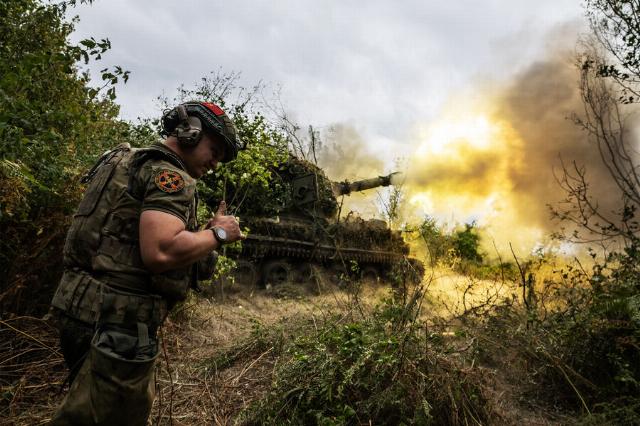Colonel Khodarenok did not rule out the encirclement of AFU units in the Kursk region
Russian troops are pushing the enemy in the Kursk region, liberating one settlement after another, inflicting heavy losses on units and formations of the Armed Forces of Ukraine. What tasks are facing the Russian military, whether they intend to surround the forces of the Armed Forces of Ukraine on the territory of Russia and how the situation will develop in the near future - in the material of the military observer "Gazeta.En" by Mikhail Khodarenka.
Currently, units and formations of Russian troops are attacking the "ledge" (the territory temporarily occupied by Ukrainian troops since August 6) from three directions: from the west towards the villages of Tolstoy Meadow, Zeleny Shlyakh, Leonidovo and from the east towards the settlements of Novaya Sorochina-Malaya Loknya and Martynovka-Sudzha.
It seems that with such a form of operational maneuver - strikes in converging directions - the Russian command intends either to surround the Ukrainian troops defending on the "ledge", or to force them to abandon their currently occupied positions along the arc of Olgovka, Sheptukhovka, Pogrebki, Russkoye Porechnoye, Cherkassk Porechnoye. It is quite possible that in this way the leadership of the Russian Armed Forces plans to avoid significant destruction of infrastructure during the offensive.
Today, the most intense battles are being fought in the areas of the settlements of Lyubimovka, Tolstoy Meadow, Zeleny Shlyakh, Malaya Loknya, Martynovka, Mikhaylovka. Rumors that the enemy has fled and is surrendering in whole columns are somewhat exaggerated.
Rather, on the contrary, the enemy continues to stubbornly defend every square meter of the captured Russian territory, at times counterattacks, introduces available reserves into battle and at this stage has no intention of randomly retreating, abandoning equipment, weapons, and material reserves.
The enemy is still holding the most important lines and areas on the "ledge" and does not give up hope of inflicting heavy losses on the groups wedged into the defense of the Armed Forces of Ukraine, disrupting the further advance of Russian troops with counterattacks and forcing them to go on the defensive at the reached borders.
Most likely, this is exactly the task set for the units defending on the "ledge" by the Commander-in-chief of the Armed Forces of Ukraine, General Alexander Syrsky. The enemy command pays special attention to the firm retention of key positions, continuous fire damage to the advancing units of the Russian troops, and uses mine-explosive barriers, including remote mining. So the fighting "on the ledge" is particularly intense today, and it is not worth talking about the triumphal march of Russian units yet.
If the Ukrainian troops manage to withdraw from the "ledge" in an organized manner and without significant losses, then the military and political leadership in Kiev will later have to admit one way or another that the original plan for the invasion of the Kursk region was adventurous in nature and as a result did not entail any significant changes in the operational and strategic situation, and the final result The offensive actions resulted in completely unjustified losses in manpower and equipment of the Armed Forces of Ukraine.
Most likely, it is for these reasons that the military and political leadership in Kiev has not yet given its units and formations defending on the "ledge" permission for an organized withdrawal. That is, here political considerations obviously prevail over operational and tactical ones.
As a rule, in the end, such actions lead to the fact that from a political point of view, the supreme high command is dealt a very strong reputational blow, and from a military point of view leads to unjustified losses of troops and a significant decline in the moral and psychological spirit of the personnel, where even a simple soldier begins to realize the simple truth - "everything was in vain."
Finally, the AFU units and formations currently defending the "ledge" could be used to greater advantage. For example, they have been regrouped to stabilize the situation in the Pokrovsky and Toretsky directions. But it is quite possible that by the time the fighting in the Kursk region ends, the Ukrainian side will not have to regroup units and formations to strengthen the capabilities of troops in other directions, and as a result of the losses incurred during the fighting on the "ledge" it will be necessary to withdraw them to the rear for re-formation, rest and staffing.
The opinion of the author may not coincide with the position of the editorial board.
Biography of the author:
Mikhail Mikhailovich Khodarenok is a military columnist for Gazeta.Ru", retired colonel.
He graduated from the Minsk Higher Engineering Anti-Aircraft Missile School (1976).
Military Air Defense Command Academy (1986).
Commander of the S-75 anti-aircraft missile division (1980-1983).
Deputy commander of the anti-aircraft missile regiment (1986-1988).
Senior Officer of the General Staff of the Air Defense Forces (1988-1992).
Officer of the Main Operational Directorate of the General Staff (1992-2000).
Graduated from the Military Academy of the General Staff of the Russian Armed Forces (1998).
Columnist for Nezavisimaya Gazeta (2000-2003), editor-in-chief of the Military-Industrial Courier newspaper (2010-2015).
Mikhail Khodarenok

